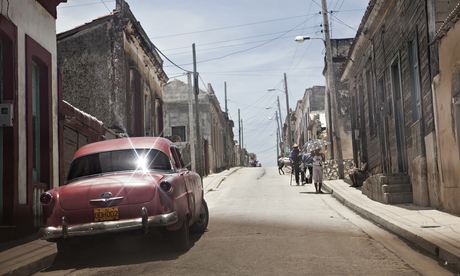
Where is Gibara?
In Cuba, at the end of the highway heading out of Holguín (reached by domestic flight from Havana), the pleasant, park-filled capital of the province of the same name in the south-east of the country.
What's the vibe?
Gibara is an independent-spirited, coastal fishing village of charming squares and run-down Spanish-era buildings on a cobalt bay. The train line was suspended in 1958, just before the Revolution, and there's a feeling that the town has been snoozing ever since. No one has bothered to plaster the town with revolutionary slogans and there is no internet, but its isolation has helped it retain its character and natural good looks.
Why go?
An annual film festival and interesting trading past combine cultural relevance and historical riches in an authentically Cuban formula that's catnip to travellers disenchanted by tourist-sated places. Gibara is not yet on "the trail", though locals are responding to the growing stream of independent travellers by opening guesthouses and restaurants, and there is talk of running a tourist train to here from the resort of Guardalavaca, which could be a game-changer.
What's all this about a film festival?
In 2003, Humberto Solás, the enfant terrible of Cuban cinema, started Gibara's Festival Internacional del Cine Pobre (festival of low-budget cinema). Latin America's coolest indie film festival draws a global audience every April and, although the word on the street is that the festival has lost focus since Solás died in 2008, it's still a worthwhile place to breathe in Cuba's lively creative spirit. This year, 47 films were shown at the town's only cinema, the charming Cine Jiba. After hours, bearded intellectuals gather for chats at the Casa de la Cultura, but locals are more drawn to the simultaneous street party, descending on the town by the truckload to enjoy the street food stalls, live comedy and disco dancing. Residents pull rocking chairs out on to the pavement to get a better look.
What's the history?
Founded in 1817, Gibara was a key port that grew wealthy on trade links with the Spain and the US. A small fortress – now ruined – protected the town and its prevalence of wealthy merchant families. When the highway was built in the 1920s, Gibara's strategic importance dipped, and the loss of the train sped its demise. In 2008, Hurricane Ike nearly blew the town away, and in 2012, Sandy dealt a second blow, so it's run-down – but stay a while and the town's rustic prettiness will start to rub off on you.
When should I go?
In May, shortly after Cine Pobre, the Romerías de Mayo takes place in Holguin. It's an eclectic arts festival led by the Hermanos Saíz Association, a group of young Cuban artists that celebrates the work of local musicians, actors, artists, writers and dancers. You can easily take in both festivals in one trip. The town is hoping to put on more creative events, including an international tango festival slated for 2015; the three-day Cine de la Cueva in January, with subterranean movie showings in the Panadernos Caves; and, also in January, the Semana de la Cultura (week of culture).
Where can I sleep?
The Cuban government doesn't excel at hotel renovations but something went right in the revamp of the Hotel Ordoño Encanto (Calle J Peralta, +53 24 844 448, doubles from £28 B&B), a 27-room colonial gem that reopened just last year with a two-floor roof terrace, original cornicing and a beautiful, frescoed master suite.
What is there to look at?
Gibara is a place to hang out rather than tick off monuments, but worth a look are the Museo de Arte Colonial (Calle Independencia 15) and the Museo de Historia Natural (Calle Luz Caballero 23), which has a collection of stuffed birds and a great whale skeleton (explanations in Spanish only). Stained-glass windows were a feature of local architecture in the town's heyday. Ask around and locals will point you to any number of houses with vitrales – it's the kind of place where people freely admit you into their homes.
What can I do in the surrounding area?
A lot. Your secret weapon should be Ernesto Blanco and Arturo Rojas, a couple of over-educated forty-somethings (a Holguín arts professor and the president of the Cuban cave diving association – book their services through esenciaexperiences.com). They can take you to search out wildlife in valleys and cave-filled limestone hills, or diving in the magical Tanque Azul de Caletones, a flooded cavern on the region's most important migratory bird route. Don't miss the area's best beach – the Playa de Caletones, a wild-west-style village 17km west of town, where you can have a slap-up lunch at La Esperanza, a shell-edged beach shack that does a mean spread of marlin, red snapper, crab, tostones (refried plantain), crisp salad and cold beer.
Where else can I go to eat?
Knock on the door of Angel and Ivan's blue-and-yellow waterfront house Hostal Sol y Mar (Calle J Peralta 59, +53 52 402 164) and ask the charming multi-lingual owners for a piña colada on their new roof terrace. They can also whip up seafood on request. La Cueva (no address but ask for "Paladar La Cueva") is a jolly restaurant that specialises in supersized portions of fresh fish. Neither will break the bank.
• The trip was provided by Steppes Travel (0843 778 9926, steppestravel.co.uk). A seven-night stay costs from £1,785pp, including flights from London with Virgin Atlantic, internal flights, private transfers, three nights in a casa particular (private house) in Havana, four nights in Gibara at the Hotel Ordoño Encanto and three days of hiking and diving excursions

